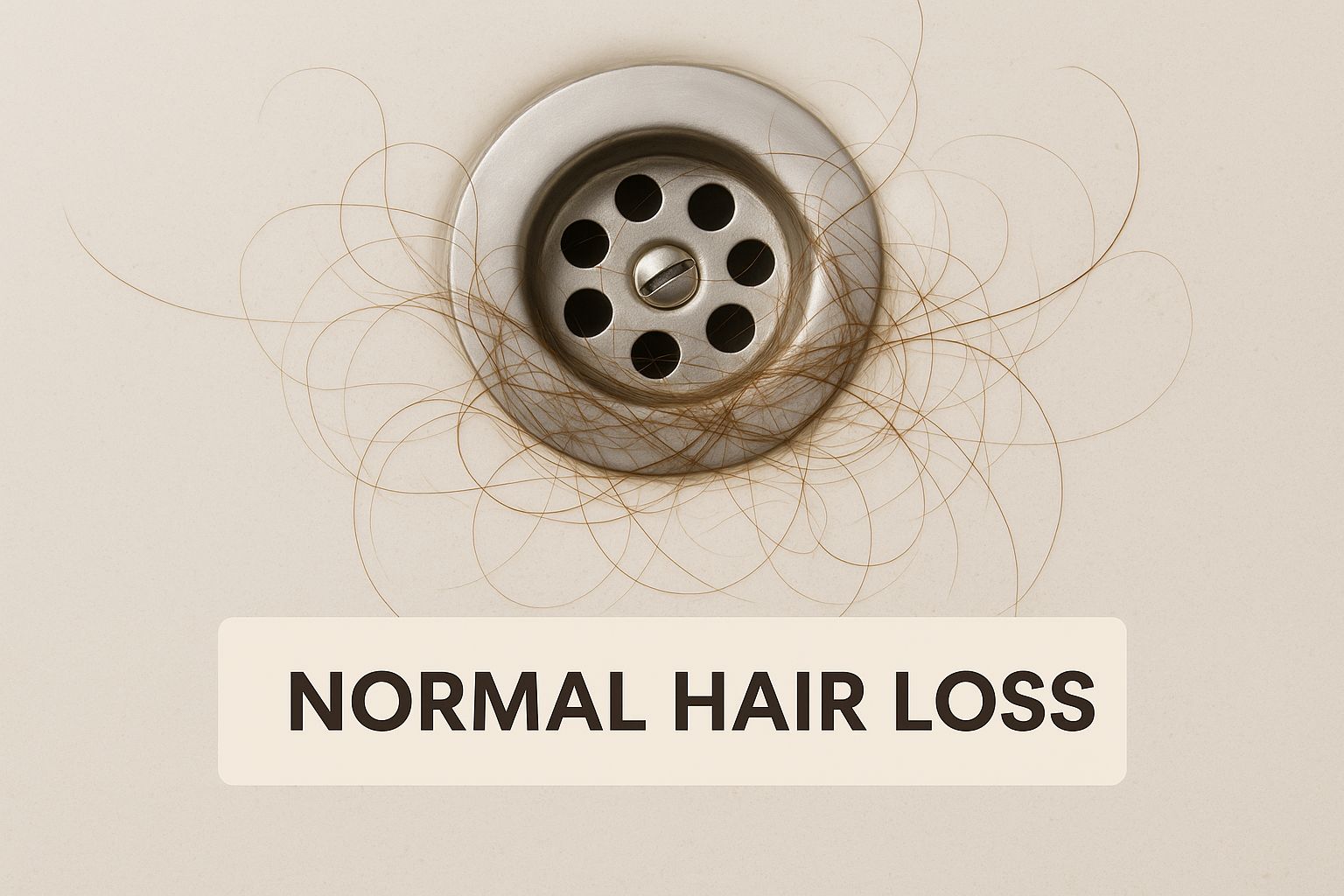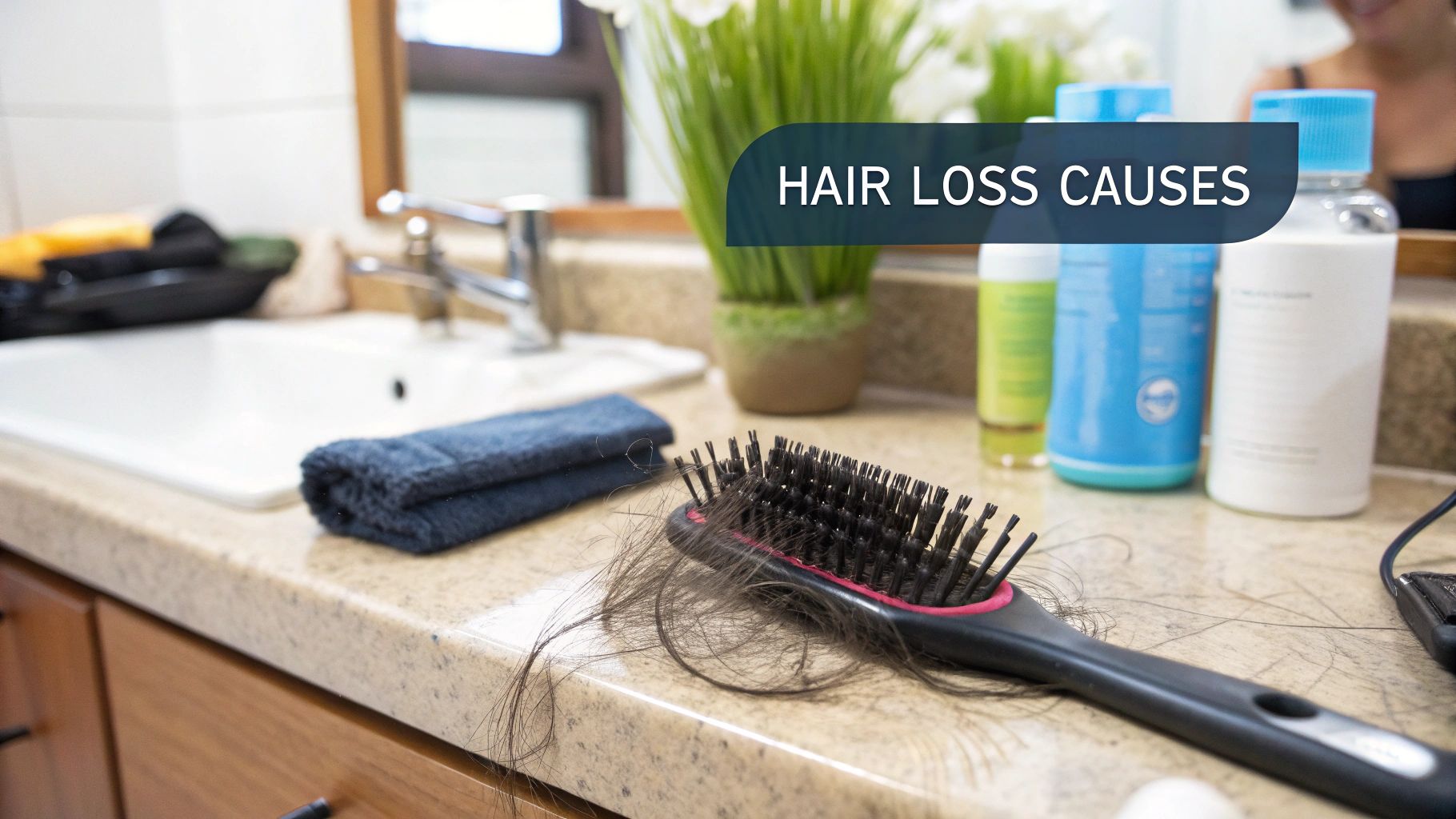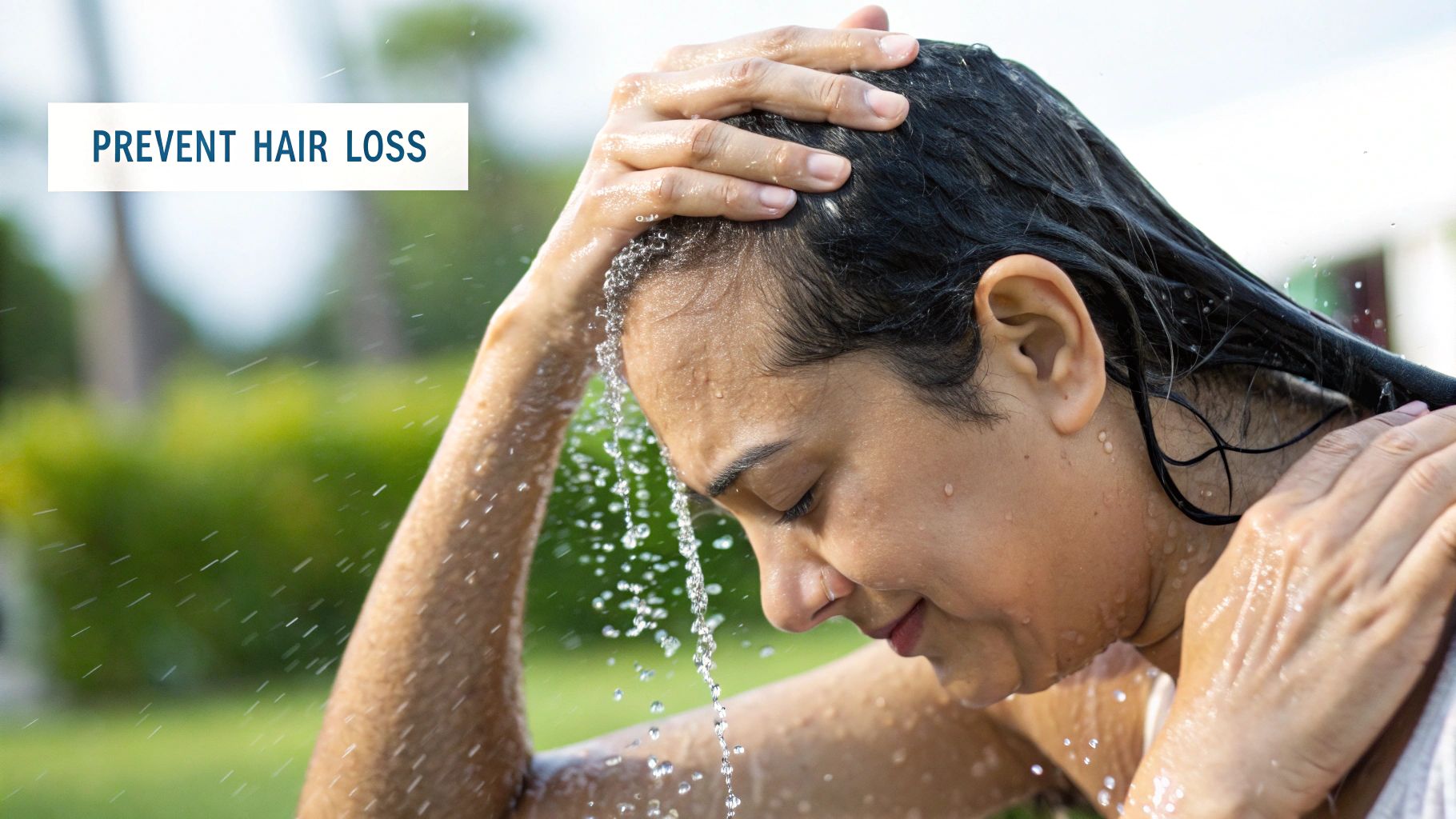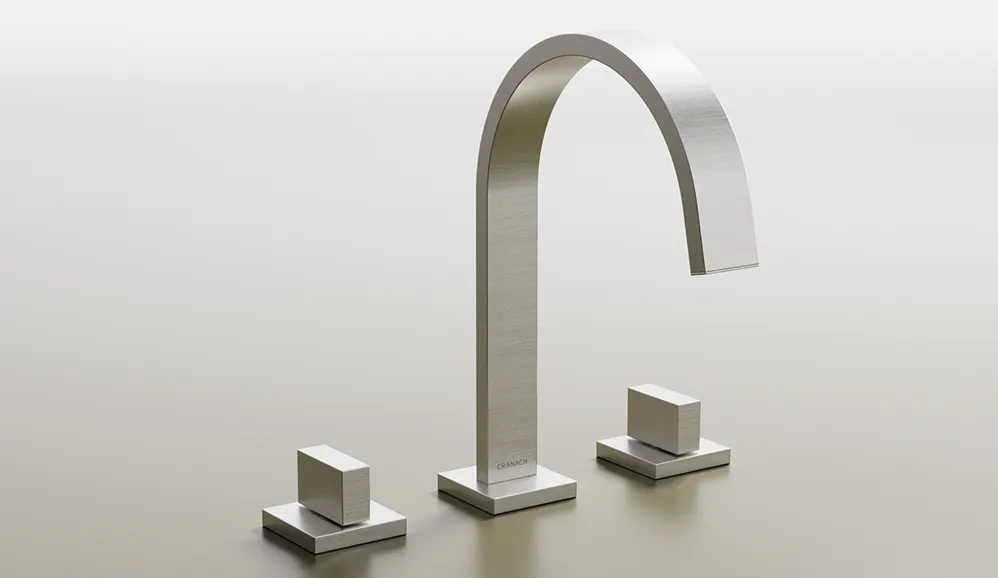That unsettling clump of hair swirling by the drain is enough to make anyone’s heart skip a beat. But here’s the thing: losing some hair in the shower is completely normal. In fact, you can expect to lose between 50 to 150 hairs every single day, and a lot of that happens when you’re washing your hair. How often you shampoo is the real key to understanding what you see.
What Normal Hair Loss in the Shower Looks Like
First, let’s get one thing straight: seeing hair in the drain isn’t automatically a sign that something is wrong. It’s just part of your hair’s natural life cycle. Think of your scalp as a garden—it’s constantly growing new sprouts while letting go of the old ones that have finished their time. The friction and water from a shower simply help dislodge the hairs that were already on their way out.
The real trick is knowing what “normal” looks like for you, because it’s heavily tied to your washing routine. The average person has somewhere between 100,000 to 250,000 strands of hair, so losing a tiny fraction of that is just healthy maintenance.
So, how much is too much? It all comes down to how often you wash your hair.
Normal Hair Loss Based on Washing Frequency
| Washing Frequency | Estimated Hair Loss Per Shower |
|---|---|
| Daily Washers | 50-70 hairs |
| Every-Other-Day Washers | 100-150 hairs |
| Weekly Washers | 150-300+ hairs |
As you can see, the numbers can look drastically different. A larger clump of hair after a few days without washing is usually just the accumulated total of normal daily shedding. It’s not a sudden, massive loss.
The amount of hair you see is directly related to your wash frequency. A larger clump after a few days without washing is often just the accumulated total of normal daily shedding.
This perspective can help reframe the situation from alarming to just routine. And while you’re in the shower, keeping your fixtures clean can make a difference in your overall experience. If you notice hard water is building up, you can check out our guide on how to clean a shower head with vinegar.
Ultimately, the hair you see in the drain is usually just evidence of a healthy, functioning scalp making way for new growth.
Understanding Your Hair’s Natural Growth Cycle
Seeing a clump of hair in the shower drain can be unsettling, but it’s rarely a sign that something is wrong. In fact, it’s usually just a visible part of a completely normal, healthy process. To get to the bottom of what’s happening, you first need a solid understanding of the hair growth cycle, which is what dictates how our hair naturally sheds and regrows.
Think of your scalp as a garden where every single hair has its own lifecycle. At any given time, about 85% to 90% of your hair is in an active growth phase called Anagen, which can last for several years. After that, each strand eventually moves into a short resting phase before it finally sheds, making way for a new one to grow in its place.
This is a visualization of how normal hair loss is just one part of the bigger picture, with those shed hairs often accumulating in the drain when you wash your hair.

The hair you find in your drain has simply finished its journey. It’s now being replaced by fresh, new growth from the same follicle.
The Shedding Phases Explained
The actual process of losing hair is concentrated in the final two phases of this cycle. Once you understand these stages, you’ll see why finding hair in your brush or shower drain is a daily occurrence.
- Telogen Phase: This is the “resting” stage. For about two to four months, the hair follicle is dormant and the strand stops growing. It stays attached, but it’s essentially just waiting to be shed.
- Exogen Phase: This is the active “shedding” stage. The old, resting hair detaches and falls out. It’s often pushed out by the brand-new hair growing in right behind it. The physical act of washing and rinsing simply helps these ready-to-go strands fall away.
This constant cycle ensures your hair is always renewing itself. The hairs you lose in the shower were already scheduled to fall out; the shower just helped them on their way.
When you look at it this way, shedding shifts from being a source of worry to a visible sign of a healthy, functioning scalp. Each lost strand is just making room for a new one, which is how your hair stays full and vibrant over time.
Everyday Factors That Influence Hair Shedding

So, we know the natural hair growth cycle is the main driver behind shedding. But what about all the other things happening in your life? Several everyday factors can absolutely influence how much hair you see swirling down the drain, and getting to know them can help you figure out what’s truly normal for you.
One of the biggest variables is simply your hair type. It’s a matter of perception. If you have long, thick, or curly hair, shed strands are just far more noticeable. A single long, dark hair can look as alarming as a clump of shorter, lighter ones, and curls love to tangle together, creating what looks like a massive hairball.
Even the water in your pipes can play a part. Hard water is packed with minerals that can leave buildup on your strands, making them more prone to tangles and breakage. That breakage can easily be mistaken for shedding straight from the root. If you think this might be an issue, you might want to look into how to increase water pressure in your shower, as it can sometimes be related.
Internal and External Influences
Beyond your hair itself, your body’s internal state and your external environment are major players. These things can temporarily throw your hair’s growth rhythm out of whack, leading to a noticeable uptick in shedding.
- Hormonal Changes: Life events like pregnancy, childbirth, or menopause bring on massive hormonal shifts. This can push a larger-than-usual number of hairs into the resting phase all at once, leading to increased shedding a few months down the line.
- High Stress Levels: We’ve all been there. Chronic stress can trigger a condition called telogen effluvium, where a significant number of hair follicles prematurely enter the resting phase. The result is a temporary but often dramatic increase in hair loss.
- Seasonal Shifts: Ever notice you shed a bit more in the fall? You’re not imagining it. Some people experience “seasonal shedding,” a temporary phenomenon thought to be linked to changes in daylight and temperature. It almost always resolves on its own.
- Nutritional Deficiencies: Your hair is what you eat. It needs key nutrients to stay strong and healthy. A diet lacking in essentials like iron, zinc, and protein can weaken the follicles and contribute to more shedding than usual.
By recognizing these common influences, you can better assess whether the amount of hair you lose in the shower is a reaction to your lifestyle or a normal part of your biological rhythm.
This knowledge turns confusion into clarity, empowering you to look at your daily habits and overall health for clues instead of just worrying about the drain.
When to Be Concerned About Hair Loss
While seeing some hair in the drain is a healthy sign, it’s completely natural to wonder when that shedding crosses the line into something more. The trick isn’t to obsessively count every single strand. Instead, you should start paying attention to sudden shifts in your hair’s normal behavior. It’s all about spotting patterns that are a major departure from your personal baseline.
A huge red flag is a sudden and dramatic increase in shedding that seems to come out of nowhere. If your brush or shower drain is suddenly holding double or triple the usual amount of hair, and it stays that way for a few weeks, it’s time to pay closer attention. Another warning sign is losing hair in noticeable clumps rather than as individual strands.
Key Warning Signs to Monitor
Looking at your hair and scalp over time will give you a much clearer picture than panicking over a single bad shower. Keep an eye out for these specific changes:
- A Widening Part: If you look in the mirror and notice your part line seems to be getting wider, it can be a sign of diffuse thinning across your scalp.
- Noticeable Thin Patches: The appearance of patchy spots or clearly defined areas of hair loss could point to an underlying issue.
- Visible Scalp: Seeing more of your scalp through your hair is a classic sign of thinning, especially around the crown or temples.
The most important thing to watch for is a sustained change from your normal shedding pattern. One day of heavy shedding is rarely a cause for alarm, but if it keeps happening for weeks on end, it’s worth investigating.
If you’re noticing any of these signs, it might be a good idea to think about seeking professional advice. For a deeper dive into the various factors at play, this guide on understanding hair loss causes and solutions is a great resource. It’s also worth noting that longer showers can make it seem like you’re losing more hair, so it can be useful to be mindful of how many gallons of water a shower uses as you track your routine.
Simple Habits For Healthier Hair And Less Breakage

You have more control over your hair’s health than you might think. By adopting a few simple, gentle habits, you can build strong, resilient strands and cut down on the breakage that often gets mistaken for true hair loss.
Let’s be honest, a lot of the hair you find in the drain isn’t falling from the root at all. It’s the result of mechanical stress from brushing, styling, and washing. A little bit of gentle care goes a long way in reducing this kind of shedding.
Gentle Hair Care Strategies
Making small tweaks to your daily routine can have a surprisingly big impact. Your main goal should be to treat your hair with kindness, especially when it’s wet and at its most fragile.
- Detangle the Right Way: Never, ever rake a brush through sopping wet hair. Instead, reach for a wide-tooth comb. Start detangling from the ends and slowly, gently work your way up to the roots. This prevents the harsh tugging that snaps strands.
- Loosen Up Your Styles: Those super-tight ponytails, buns, or braids might look sharp, but they put constant strain on your hair follicles. Over time, this can lead to traction alopecia, a type of hair loss from persistent pulling. Give your roots a break by opting for looser, more relaxed hairstyles.
- Choose Products That Nourish: Look for shampoos and conditioners that are designed to hydrate and strengthen your hair. If you’re seeing a lot more shedding than usual, it could be worth exploring options like the best Japanese shampoos specifically formulated for hair loss.
A mindful hair care routine is a fantastic form of self-care. To get more ideas on building a relaxing and beneficial shower experience, take a look at our guide on what an “everything shower” for women entails.
Key Takeaway: Being proactive with gentle handling and the right nourishing products is your best defense against unnecessary breakage and hair fall.
And remember, truly strong hair starts from the inside out. Make sure your diet is packed with essential nutrients like iron, zinc, and biotin—the fundamental building blocks for healthy hair. These simple, actionable steps give you the power to improve your hair’s health and give you some well-deserved peace of mind.
Common Questions About Shower Hair Loss
Even when you know the basics of the hair growth cycle, it’s completely normal to have some nagging questions. Seeing a clump of hair in the drain can be unsettling, no matter how many times you’re told it’s fine.
Let’s tackle some of the most common worries head-on. Getting straight answers can help you feel much more confident about what’s happening on your head and in your shower.
Quick Answers to Your Hair Questions
Still have questions? We get it. Here are some rapid-fire answers to help put your mind at ease. This handy table gives you the short and sweet of it, with more detail below.
Quick Answers to Your Hair Questions
Here are concise answers to common questions about hair loss that can provide quick reassurance and guidance.
| Question | Short Answer |
|---|---|
| Does water temperature matter? | Extremely hot water won’t make hair fall from the root, but it can strip natural oils, leading to dryness and breakage. Lukewarm is best. |
| Do my shampoo or conditioner cause this? | Unlikely. Unless you’re having an allergic reaction, these products just help already-shed hair to slip out. The friction from washing is what dislodges hairs that were ready to go. |
| Is hard water making my hair fall out? | No, hard water doesn’t directly cause shedding from the follicle. It can, however, cause mineral buildup that makes hair dry, brittle, and more prone to snapping. |
| Should I brush my hair before or after? | Before! Always detangle gently with a wide-tooth comb before you wash. Wet hair is much more fragile and susceptible to breakage. |
| Can conditioner make my hair fall out? | Conditioner itself does not cause hair loss. Because it makes hair so slippery, it simply allows the strands that have already shed to slide out easily, which is why you notice them more at this stage. |
Let’s dive a little deeper into a few of these.
One of the most frequent questions we hear is about water temperature. While a scorching hot shower might feel great, it isn’t doing your hair any favors. It won’t directly cause hair to fall out from the root, but it can strip your scalp and hair of their natural, protective oils. This leads to dryness and brittleness, making your hair much more likely to break.
Another common worry is about products. Are certain shampoos or conditioners making things worse? Generally, no. Harsh chemicals can definitely damage the hair shaft, but they don’t typically cause shedding from the follicle itself. What’s really happening is that the physical act of massaging in shampoo is what dislodges the hairs that were already in their “resting” phase, just waiting for a little nudge to fall out.
Similarly, hard water is often blamed for hair loss. The minerals in hard water can build up on your hair, making it feel dry, tangly, and prone to breakage, but it’s not the root cause of shedding. Sometimes, just improving your shower’s flow can make a difference in how your hair feels. If you’re curious, you can learn more about how to increase the pressure of water in your shower with some easy fixes.
Ultimately, knowing how much hair is normal to lose in the shower comes down to understanding your personal baseline. Consistency is key—if your shedding pattern remains stable over time, it’s almost always just a sign of a healthy, functioning hair cycle.
At Cranach, we believe in the power of a healthy, therapeutic shower experience. From our elegant shower systems to our premium faucets, we design products that enhance your daily wellness routine. Explore our collection and elevate your bathroom today.










